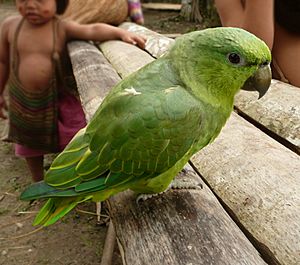Short-tailed parrot facts for kids
Quick facts for kids Short-tailed parrot |
|
|---|---|
 |
|
| At a Peruvian village | |
| Conservation status | |
| Scientific classification | |
| Genus: |
Graydidascalus
|
| Species: |
brachyurus
|
 |
|
The short-tailed parrot (scientific name: Graydidascalus brachyurus) is a cool bird that lives in the rainforests of South America. It's part of the parrot family, just like many other colorful parrots you might know. You can find this parrot in countries like Brazil, Colombia, Ecuador, French Guiana, and Peru.
Contents
About the Short-tailed Parrot
Scientists group animals together based on how they are related. The short-tailed parrot is the only type of bird in its special group, called a genus. It does not have any different kinds, or subspecies. Its closest bird relatives are the yellow-faced parrot and other parrots in the Pionus group.
What Does It Look Like?
The short-tailed parrot is about 24 to 25 centimeters (9 to 10 inches) long. It weighs between 188 and 233 grams (6.6 to 8.2 ounces). This parrot has a big head and, as its name suggests, a very short tail.
Most of its body is green. Its belly and the feathers under its tail are a bit yellowish. The feathers around its eyes are dark. Its main wing feathers are a darker green. The edges of its wing feathers are yellow. You might see a reddish-brown patch on its shoulder, but usually only when it's flying. The outer tail feathers have red stripes at their base. Its beak can be light green or dark gray. Its eyes are orange-red. Young parrots look like adults, but they don't have the red on their tails.
Where Does It Live?
The short-tailed parrot lives along the Amazon River and its smaller rivers. You can find it from southern Colombia, northeastern Ecuador, and northeastern Peru all the way to the Atlantic Ocean. Its home also stretches north along the coast of Brazil into northeastern French Guiana.
Along the rivers, it likes to live in várzea forests. These are swampy areas that flood often. It also lives on islands in the rivers and in mangrove forests along the coast. Sometimes, it can even be found in areas where people grow crops. It lives from sea level up to about 400 meters (1,300 feet) high.
How Does It Behave?
Movement
Scientists think the short-tailed parrot moves around sometimes. This might happen when the rivers flood at different times of the year.
What Does It Eat?
The short-tailed parrot loves to eat fruits. It especially likes figs. It also enjoys fruits from cultivated plants like guava and mango. Besides fruits, it eats seeds, nuts, berries, and the long, hanging flowers called catkins from Cecropia trees.
Reproduction and Life Cycle
Not much is known about how the short-tailed parrot raises its young. We know that its breeding season seems to include the month of September. More research is needed to learn about its nesting habits and how it cares for its chicks.
Vocalization and Sounds
The short-tailed parrot can be quite noisy! When it flies, it makes a high-pitched, rolling sound like "kree-ki-ki." When it's sitting, it makes many different loud, harsh, and "chatty" calls.
Is the Short-tailed Parrot Safe?
The IUCN (International Union for Conservation of Nature) says the short-tailed parrot is a species of "Least Concern." This means it's not currently in danger of disappearing. It lives in a very large area. However, we don't know exactly how many short-tailed parrots there are. Scientists believe their numbers might be slowly going down. No big threats have been found right now. It is common in many places, but it's harder to find in the upper parts of the Amazon River system.
See also
In Spanish: Loro colicorto para niños



